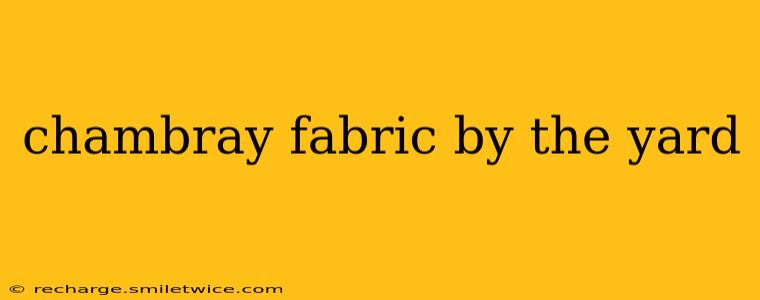Chambray fabric, with its subtly textured surface and versatile nature, has become a staple in the world of sewing and crafting. Whether you're a seasoned quilter, a fashion enthusiast, or simply someone looking for a durable and stylish fabric for a DIY project, understanding chambray's properties is key to choosing the right yardage for your needs. This comprehensive guide will explore everything you need to know about buying chambray fabric by the yard, from its unique characteristics to its various applications.
What is Chambray Fabric?
Chambray is a lightweight, plain-woven fabric typically made from cotton, although blends incorporating linen, silk, or other fibers are also available. Its distinctive appearance stems from its construction: a warp (lengthwise) yarn of a single color is woven with a weft (crosswise) yarn of a slightly different color, usually a lighter shade of the same color. This creates a subtle, almost denim-like texture but with a softer, more refined feel. Unlike denim, however, chambray is typically less tightly woven, resulting in a more breathable and drapable fabric.
What are the Different Types of Chambray Fabric?
While cotton chambray is the most common, variations exist, each offering unique qualities:
- Cotton Chambray: The classic choice, offering breathability, softness, and easy care. Ideal for shirts, dresses, and home décor projects.
- Linen Chambray: Combines the breathability of linen with the subtle texture of chambray. More expensive but offers a luxurious drape and superior durability.
- Silk Chambray: A luxurious option with a beautiful sheen and smooth drape. Perfect for special occasion garments and delicate projects.
- Chambray blends: Many blends incorporate other fibers like rayon or polyester to enhance specific properties, such as wrinkle resistance or durability.
What Makes Chambray Fabric Unique?
Several factors distinguish chambray from other fabrics:
- Subtle texture: The slight color variation between warp and weft creates a unique visual interest.
- Lightweight and breathable: Its open weave makes it ideal for warmer climates and summer garments.
- Drapable: It drapes well, making it suitable for a variety of garments and applications.
- Versatile: It can be used for both casual and more formal projects.
- Easy to sew: Its manageable weight and weave make it a pleasure to work with for both beginners and experienced sewers.
What are Chambray Fabric's Uses?
The versatility of chambray fabric makes it suitable for a vast array of projects:
- Apparel: Shirts, blouses, dresses, skirts, and even jackets.
- Home décor: Curtains, bedding, pillowcases, and tablecloths.
- Quilting: Its softness and drape make it a popular choice for quilt tops.
- Accessories: Bags, scarves, and headbands.
- Craft projects: Perfect for creating tote bags, bunting, or other decorative items.
How Much Chambray Fabric Do I Need?
The amount of chambray fabric you need will depend on your project. Always check the pattern instructions for specific yardage requirements. When in doubt, it's always best to buy a little extra to account for potential errors or adjustments.
Where Can I Buy Chambray Fabric by the Yard?
Chambray fabric is widely available from a variety of sources:
- Online retailers: Many online fabric stores offer a wide selection of chambray in various colors and weights.
- Local fabric stores: Your local fabric store is a great place to see and feel the fabric before you buy.
- Craft stores: Some craft stores also carry a selection of chambray fabric.
Is Chambray Fabric Easy to Care For?
Generally, chambray fabric is easy to care for. Always check the care instructions on the fabric label, but most cotton chambray can be machine washed and dried. For linen or silk chambray, hand washing or delicate cycle washing may be recommended.
What are the Benefits of Buying Chambray Fabric by the Yard?
Buying chambray by the yard offers several advantages:
- Choice: You can select the exact amount you need, avoiding waste.
- Customization: You can choose the color and pattern that best suits your project.
- Cost-effectiveness: Buying in bulk can often be more economical.
What are Some Alternatives to Chambray Fabric?
While chambray is unique, several fabrics offer similar properties:
- Denim: Heavier weight and more durable.
- Cotton poplin: Smoother and more crisp.
- Lightweight linen: Similar drape and breathability.
This comprehensive guide provides a solid foundation for understanding and utilizing chambray fabric. Remember to consider the project's requirements and your personal preferences when selecting your chambray fabric by the yard. Happy sewing!
